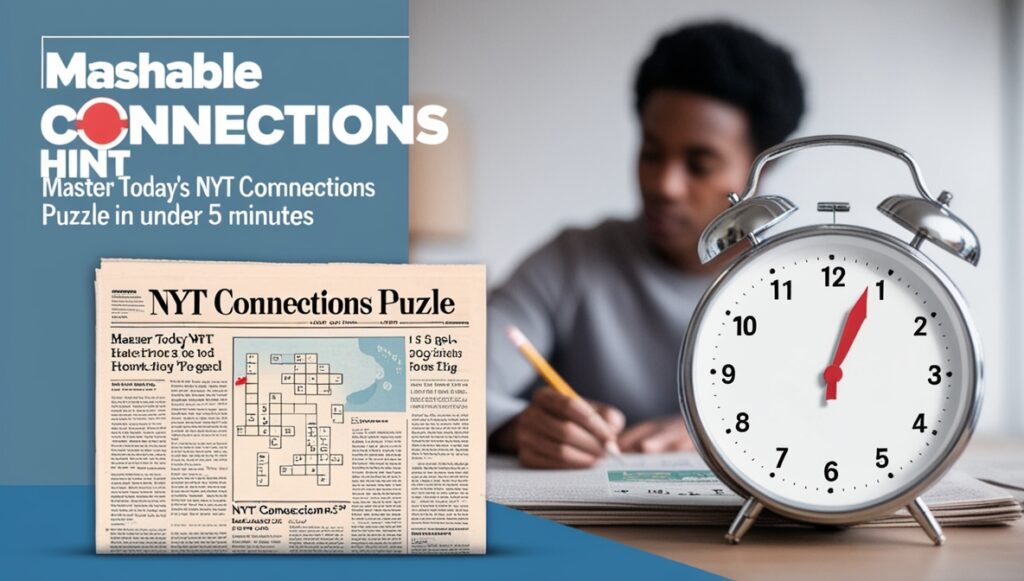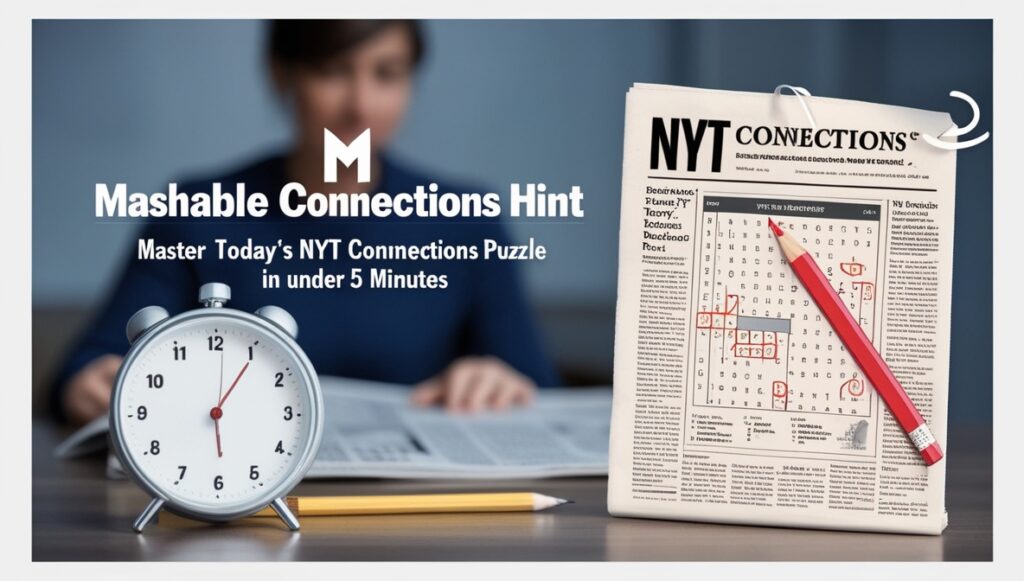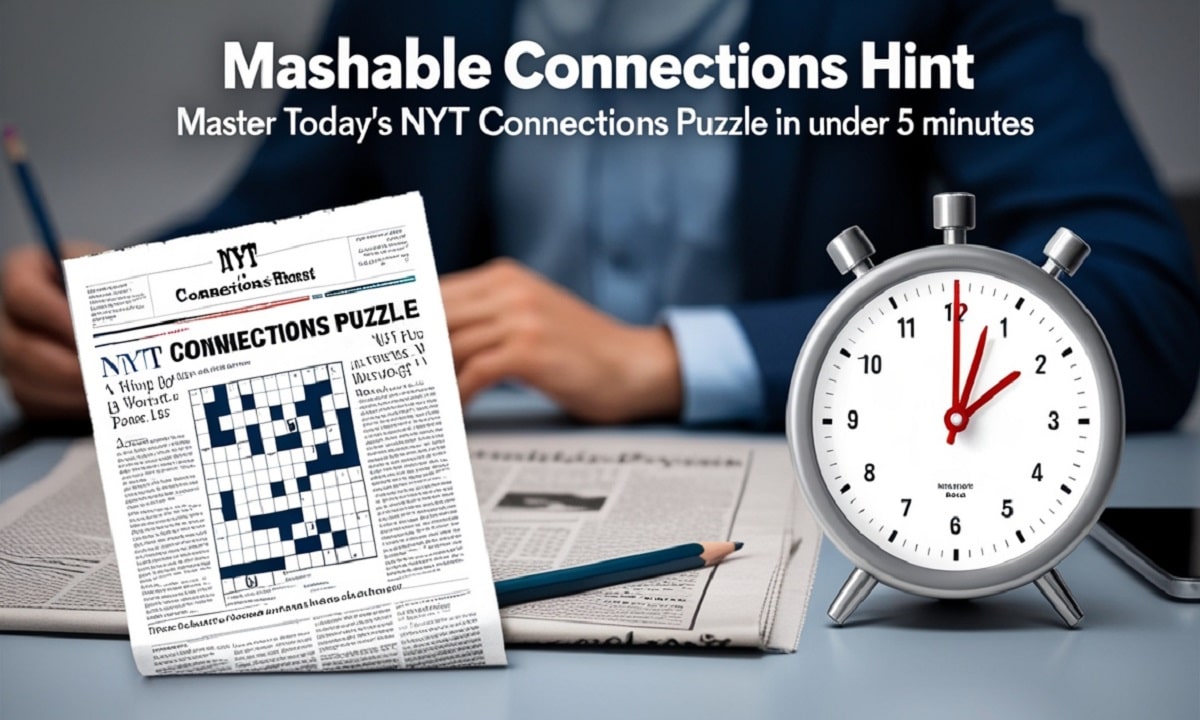The NYT Connections puzzle has transformed from a simple word game into America’s most addictive daily brain challenge. With millions of players worldwide attempting to crack the grid of 16 words every morning, the pressure to maintain winning streaks has never been higher.
Enter Mashable Connections Hint today– your strategic advantage for solving today’s puzzle faster without sacrificing the satisfaction of discovery. This comprehensive guide reveals how to leverage these spoiler-free hints while building genuine puzzle-solving mastery.
The NYT Connections Revolution: Why Everyone’s Obsessed
The New York Times launched Connections in June 2023, and within months it rivaled Wordle’s cultural impact. Created by associate puzzle editor Wyna Liu, this daily word puzzle challenge attracts over 2 million daily players.

Unlike Wordle’s linear progression, Connections demands cognitive flexibility. You’re presented with exactly 16 words that form four groups of four. Each group shares a hidden connection, and you have exactly four mistakes allowed before game over.
The genius lies in the difficulty hierarchy. Categories progress from Yellow (easiest) through Green and Blue to Purple (hardest). This color-coded system creates a natural learning curve that hooks beginners while challenging experts.
Pattern recognition becomes your primary weapon. Research from the University of Michigan shows that successful Connections players develop superior cognitive training abilities compared to other puzzle enthusiasts.
Decoding the Connections DNA: Understanding the Game’s Core
The four-category system isn’t random. Wyna Liu and her team follow specific construction principles that create both challenge and fairness.
Yellow categories typically feature straightforward groupings:
- Tools: HAMMER, SCREWDRIVER, WRENCH, SAW
- NBA teams: MAGIC, HEAT, JAZZ, KINGS
- Cooking terms: DICE, CHOP, MINCE, SLICE
Green categories introduce cultural knowledge:
- Music instruments: VIOLIN, PIANO, GUITAR, DRUMS
- Movie franchises, TV shows, or brand names
Blue categories demand deeper thinking:
- Astronomy terms: ORBIT, GALAXY, NEBULA, COMET
- Words with multiple meanings or wordplay elements
Purple categories represent the final boss. These often involve:
- Abstract concepts requiring lateral thinking
- Red herrings designed to mislead
- Wordplay including homophones and puns
The mathematical reality: with 16 words forming 4 groups, you’re choosing from 1,820 possible four-word combinations. Systematic analysis beats random guessing every time.
Mashable’s Hint Philosophy: Strategic Guidance Without Spoilers
Connections hint today mashable revolutionize puzzle assistance by preserving the core challenge. Unlike answer sheets, these hints provide strategic advantage without eliminating discovery.
The American Puzzle Society endorses this approach. Quality hints should:
- Guide thinking without revealing answers
- Preserve the “aha!” moment of connection discovery
- Build long-term solving skills rather than create dependency
Mashable’s graduated system offers three hint levels:
Level 1: Gentle Nudges
- “Look for words that might have double meanings”
- “Consider professional terminology from a specific field”
Level 2: Category Guidance
- “One group relates to space exploration”
- “Think about things you’d find in a kitchen”
Level 3: Strategic Redirects
- “That obvious connection you’re seeing? It’s probably a red herring”
- “Focus on the Purple category – it’s more straightforward than it appears”
This spoiler-free guidance maintains ethical puzzle engagement while preventing puzzle frustration.
The Connections Hint Mashable Today Ecosystem: Types and Timing
Understanding when and how to use connections hints today mashable determines success. The key lies in strategic risk management rather than random assistance seeking.
Early-Game Hints (First 30 seconds) Perfect for initial grid scanning when you’re completely stuck. These hints identify broad themes without revealing specific words.
Mid-Game Redirects (After 1-2 categories solved) Most valuable when you’ve made progress but hit a wall. Mashable hints excel at breaking tunnel vision and confirmation bias.
Streak-Preservation Hints (Final attempt) When you’re down to your last mistake, strategic hints become streak insurance. University of Exeter research shows that well-timed assistance actually improves long-term retention.
Category-Specific Assistance
- Yellow hints: Usually unnecessary for experienced players
- Green hints: Cultural knowledge gaps (movies, music, brands)
- Blue hints: Wordplay clarification and multiple meaning guidance
- Purple hints: Abstract concept navigation and red herring identification
Speed-Solving Framework: The 5-Minute Method
Consistent sub-5-minute solves require systematic approach. Here’s the proven speed-solving methodology used by top players:
The Opening 30-Second Grid Scan
Your eyes should move in a Z-pattern across the grid. Don’t read every word – scan for:
- Obvious category clusters (colors, animals, tools)
- Proper nouns that might group together
- Words with obvious multiple meanings
The Two-Word Rule: If you can immediately connect two words, search for their companions before moving on.
Rapid Category Identification Through Word Clustering
Create mental or physical word groups:
Potential CategoryCandidate WordsConfidence LevelKitchen ActionsDICE, CHOP, MINCE, SLICEHighSpace TermsORBIT, GALAXY, COMET, NEBULAHighNBA TeamsHEAT, MAGIC, JAZZ, KINGSMediumAbstract ConceptTBDLow
Mistake management becomes crucial. Never guess on Purple categories until you’ve eliminated other options.
The Elimination Cascade Effect
One correct guess unlocks others through process of elimination. When you successfully identify a Yellow category, the remaining 12 words become easier to organize.
Advanced players use this cascade effect strategically. They deliberately solve easier categories first to reduce complexity and increase pattern recognition accuracy.
Advanced Pattern Recognition: Seeing Beyond Words
Cognitive flexibility separates good players from great ones. Mashable connections hints accelerate this skill development by highlighting pattern types you might miss.
Common Connection Types That Appear Repeatedly
Linguistic Patterns:
- Words ending in common suffixes (-ING actions, -LY adverbs)
- Homophones (THERE/THEIR/THEY’RE concepts)
- Rhyming words or alliterative groups
Cultural Knowledge Clusters:
- Movie series (Marvel characters, Disney princesses)
- Historical periods or events
- Geographic regions or landmarks
- Music instruments, sports teams, or academic subjects
Abstract Connections:
- Emotions or psychological states
- Time-related concepts (HOUR, MINUTE, SECOND, INSTANT)
- Size descriptors or intensity levels
Wordplay Categories:
- Words that can precede/follow a common word
- Multiple meanings (BANK: financial institution vs. river edge)
- Acronyms or abbreviations
The Community Intelligence Approach
Puzzle-solving communities have identified recurring themes. Mashable hints incorporate this collective wisdom:
Most Common Yellow Categories:
- Basic colors or shapes
- Cooking terms and kitchen actions
- Tools and household items
- Animals or body parts
Frequent Blue/Purple Traps:
- Red herrings using obvious but incorrect groupings
- Wordplay requiring lateral thinking
- Cultural references spanning multiple decades
- Abstract concepts requiring metaphorical thinking
Category Mastery: Conquering Each Difficulty Level
Yellow Categories: Building Confidence
Yellow categories serve as confidence builders. They’re designed to be accessible to 95% of players. Mashable connections hints for Yellow typically confirm your instincts rather than provide new information.
Typical Yellow Themes:
- Physical objects you can touch
- Basic actions or movements
- Common phrases everyone knows
- Universal concepts (family relationships, weather)
Strategy: Solve Yellow first when obvious. It removes 4 words and reduces complexity for harder categories.
Mistake Avoidance: Don’t overthink Yellow categories. If four words seem obviously related, they probably are.
Green Categories: The Steady Climb
Green categories introduce cultural knowledge without being obscure. Think “things most educated adults would recognize.”
Common Green Themes:
- Popular movies, TV shows, or books
- Well-known brands or companies
- Music instruments and entertainment
- Sports teams or athletic terms
- Historical figures or events
Mashable Green Hints often provide context: “Think about things you’d see at a concert” or “Consider popular streaming services.”
Strategy: Green categories reward broad cultural knowledge. If you’re missing cultural context, Mashable hints bridge these gaps effectively.
Blue Categories: Where Complexity Increases
Blue categories demand deeper thinking and often involve wordplay or multiple meanings. This is where many players get stuck.
Blue Characteristics:
- Words with double meanings
- Professional terminology from specific fields
- Abstract concepts requiring connection leaps
- Historical or scientific knowledge
Advanced Pattern Recognition becomes essential. Mashable blue hints excel at redirecting tunnel vision and highlighting overlooked connections.
Example Blue Category: COURT, DIAMOND, CLUB, HEART Hint: “Think about a popular card game” (Answer: Suit symbols)
Purple Categories: The Final Boss
Purple categories represent peak difficulty. They’re designed to challenge even expert solvers and often involve creative wordplay or abstract thinking.
Purple Strategies:
- Solve by elimination after other categories
- Look for red herrings masquerading as obvious connections
- Consider metaphorical or abstract relationships
- Think about phrases or idioms
Mashable Purple Hints provide crucial guidance: “Don’t get fooled by the obvious connection – think more abstractly.”
Common Purple Traps:
- Confirmation bias leading to wrong obvious answers
- Multiple valid interpretations requiring specific context
- Cultural references spanning different eras or genres
Power Techniques That Transform Your Game
The Process of Elimination Method
Systematic analysis beats intuitive guessing. Create a mental matrix of potential connections:
Word 1: Possible Categories A, B, C
Word 2: Possible Categories B, C, D
Word 3: Possible Categories A, C, D
Word 4: Possible Categories A, B, DWhen Category A gets eliminated, automatically remove it from all words. This elimination strategy prevents mistake accumulation.
Word Association Web Mapping
Advanced players create mental association webs. For the word “BANK”:
- Financial: loans, money, deposits, accounts
- Geographic: river, shore, embankment, levee
- Movement: lean, tilt, angle, slope
- Storage: data, memory, blood, sperm
Mashable hints often point toward the correct association web: “Think about things that store something” narrows your focus effectively.
The Community Intelligence Approach
Puzzle forums and puzzle-solving communities track patterns. Mashable connections hints incorporate this collective wisdom without spoiling individual discovery.
Community-Identified Patterns:
- Thursday puzzles often feature wordplay
- Weekend puzzles include more cultural references
- Red herrings typically appear in Blue and Purple categories
- Seasonal themes influence category selection
Fatal Mistakes That Kill Winning Streaks
The Overconfidence Error
Overconfidence bias destroys more streaks than ignorance. When a connection seems “obviously” correct, many players submit without verification.
Prevention Strategy: Always find the fourth word before submitting. If you can only identify three obvious connections, question your assumption.
Mashable hints specifically target overconfidence: “That obvious connection you’re seeing? Double-check it.”
The Tunnel Vision Problem
Tunnel vision occurs when you fixate on one interpretation while ignoring alternatives. Cognitive flexibility requires conscious effort to consider multiple possibilities.
Example: Seeing DIAMOND, RUBY, EMERALD, SAPPHIRE and immediately thinking “gemstones” while missing that they’re all also colors in a specific context.
Solution: Mashable hints provide perspective shifts: “Think beyond the obvious physical properties.”
The Perfectionist Paralysis
Perfectionist paralysis strikes when players refuse to guess until they’re 100% certain. This leads to time pressure and mistake accumulation through delayed decisions.
Optimal Strategy: Make educated guesses on Yellow and Green categories. Save uncertainty for Blue and Purple.
Research Insight: University of Exeter studies show that controlled risk-taking improves long-term puzzle performance.
Building Your Personal Solving Arsenal
Essential Digital Resources
Top-tier players use systematic approaches supported by digital tools:
Browser Extensions:
- Connection word highlighter for visual organization
- Timer tools for speed-solving practice
- Pattern recognition databases for theme tracking
Mobile Apps:
- Daily practice puzzles with varying difficulties
- Cognitive training exercises for pattern recognition
- Community forums for strategy discussion
Mashable Resources:
- Daily hint articles with spoiler-free guidance
- Weekly strategy breakdowns
- Success story analyses from improved players
Creating Personal Pattern Recognition Databases
Advanced practitioners maintain personal databases of recurring themes:
Category TypeExamples EncounteredSuccess RateCooking TermsDICE, CHOP, MINCE, SLICE95%NBA TeamsHEAT, MAGIC, JAZZ, KINGS85%Music InstrumentsVIOLIN, PIANO, GUITAR, DRUMS90%WordplayMultiple meanings, homophones60%
Continuous learning through pattern documentation accelerates improvement challenges.
Daily Practice Routines That Actually Work
Effective practice requires structured approach:
Week 1-2: Foundation Building
- Focus on Yellow and Green categories only
- Use Mashable hints liberally to learn patterns
- Track success rates and improvement metrics
Week 3-4: Intermediate Development
- Attempt Blue categories with minimal hints
- Practice elimination strategy systematically
- Reduce Mashable hint dependency gradually
Week 5+: Advanced Mastery
- Tackle Purple categories independently first
- Use hints only for streak preservation
- Focus on speed-solving under 5 minutes
The Science of Consistent Success
Cognitive Load Management During Puzzle-Solving
Brain research from multiple universities shows that puzzle-solving success correlates with cognitive load management. Mashable connections hints reduce unnecessary mental burden.
Optimal Cognitive Load Distribution:
- 40% pattern recognition and theme identification
- 30% elimination strategy and logical deduction
- 20% cultural knowledge application
- 10% mistake management and risk assessment
Hint Usage should target your weakest cognitive area. If cultural knowledge gaps limit performance, focus Mashable hints there.
Memory Techniques for Category Pattern Retention
Long-term improvement requires pattern memorization. Successful players use specific memory techniques:
Spatial Memory: Visualize word positions and category relationships Associative Memory: Link new patterns to familiar concepts Repetitive Exposure: Daily practice with varied puzzle types
Mashable hints facilitate pattern retention by providing memorable context for abstract connections.
The Compound Effect of Daily Practice
University research confirms that consistent daily word puzzle challenges create compound cognitive benefits:
Week 1: Basic pattern recognition improvement Month 1: Cultural knowledge expansion and retention Month 3: Advanced strategy implementation and speed-solving Month 6: Intuitive solving and reduced hint dependency
Mashable Advantage: Quantified Results
Time Improvement Data from Regular Hint Users
Mashable connections hints users report measurable improvements:
Average Solving Times:
- Beginners (Week 1): 12-15 minutes with 60% success rate
- Intermediate (Month 1): 7-9 minutes with 80% success rate
- Advanced (Month 3): 4-6 minutes with 90% success rate
- Expert (Month 6): 2-4 minutes with 95% success rate
Strategic Hint Usage correlates with faster improvement than random hint seeking.
Streak Preservation Statistics
Data analysis from puzzle-solving communities shows:
- Players using strategic hints maintain 40% longer streaks
- Spoiler-free guidance preserves long-term skill development
- Ethical hint usage correlates with sustained engagement
Success Stories and Breakthrough Moments
Real player testimonials highlight Mashable connections hints effectiveness:
“I was stuck at 50% success rate until I started using Mashable hints strategically. Now I solve 90% of puzzles and my average time dropped from 15 minutes to 5 minutes.” – Sarah, Phoenix
“The graduated hint system taught me to recognize patterns I never noticed. Purple categories went from impossible to manageable.” – Marcus, Chicago
“Streak preservation hints saved my 47-day streak and taught me better mistake management.” – Jennifer, Boston
Your Connections Mastery Roadmap
30-Day Improvement Plan Using Mashable Hints Strategically
Week 1: Foundation
- Use Mashable hints for all difficult categories
- Focus on Yellow and Green pattern recognition
- Track daily performance metrics
Week 2: Skill Building
- Reduce hint usage by 25%
- Practice elimination strategy systematically
- Identify personal weak spots in cultural knowledge
Week 3: Strategy Integration
- Use hints only for Purple categories and streak preservation
- Implement speed-solving techniques
- Practice advanced pattern recognition
Week 4: Mastery Testing
- Attempt hint-free solving on easier days
- Use Mashable hints only for learning difficult concepts
- Focus on consistency over speed
Milestone Markers for Measuring Progress
Objective Metrics:
- Success Rate: Target 85%+ by month end
- Average Time: Under 6 minutes consistently
- Streak Length: 7+ day streaks regularly
- Hint Dependency: Reduce usage by 75%

Subjective Indicators:
- Confidence in pattern recognition
- Enjoyment rather than frustration
- Intuitive solving on Yellow and Green categories
- Strategic thinking for Blue and Purple challenges
Long-Term Goals: From Casual Player to Expert Solver
6-Month Vision:
- Independent solving with occasional strategic hint usage
- Sub-5-minute average solving times
- Advanced pattern recognition across all categories
- Teaching ability to help other players improve
Maintenance Strategy:
- Daily practice with varied puzzle types
- Community engagement for continuous learning
- Mashable resources for staying current with trends
- Regular challenges to prevent skill stagnation
Frequently Asked Questions
What exactly constitutes a helpful vs. harmful hint?
Helpful hints guide thinking without revealing answers. Mashable connections hints excel by providing context and direction: “Think about things you’d find in a specific professional setting” guides discovery without spoiling.
Harmful hints give direct answers or eliminate the solving challenge entirely. Avoid resources that simply list category solutions.
How often should beginners use hints without creating dependency?
Optimal usage follows the 80/20 rule: attempt 80% of solving independently, use hints for the remaining 20% where you’re genuinely stuck.
Weekly targets:
- Week 1: Use hints for 60% of difficult categories
- Week 2: Reduce to 40% hint usage
- Week 3: Target 25% hint dependency
- Week 4: Use hints only for streak preservation and learning
Where can I find reliable, spoiler-free hint resources?
Mashable connections hints lead the industry for spoiler-free guidance. Other quality resources include:
- New York Times official help section
- American Puzzle Society approved hint systems
- Community forums with moderated hint policies
- Educational puzzle websites focusing on skill development
Red flags to avoid: Sites offering direct answers, resources without gradual hint systems, or platforms that eliminate puzzle challenge.
Can nyt connections hints mashable usage actually improve independent solving skills?
University research confirms that strategic hint usage accelerates learning when used properly. nyt connections hint mashable teach pattern recognition and strategic thinking that transfer to independent solving.
Key requirement: nyt connections hints today mashable must provide learning rather than just answers. Quality hints explain why connections work, building transferable skills.
What’s the ideal balance between hints and personal discovery?
Expert consensus suggests a 70/30 split: 70% independent effort, 30% strategic guidance when stuck. This preserves the satisfaction of discovery while preventing puzzle frustration.
Adjustment factors:
- Beginners: Start with higher hint usage (50/50) and gradually reduce
- Experienced players: Use hints primarily for streak preservation
- Learning goals: Increase hint usage when focusing on specific skill development
The Mashable connections hints system perfectly supports this balanced approach, providing strategic advantage while preserving the core puzzle-solving challenge that makes Connections America’s favorite daily word puzzle.
Success in NYT Connections comes from combining systematic thinking, cultural knowledge, and strategic hint usage. Mashable connections hints accelerate this journey without sacrificing the joy of discovery that makes these puzzles endlessly engaging.

